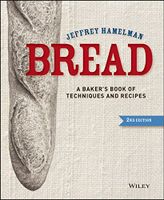Label
All
0
Clear all filters
Prue Leith's latest book is now on ckbk. Get 25% off ckbk Membership
Hand-Mixed Bread and Unkneaded Six-Fold French Bread
Appears in
Published 2004
Mixing bread dough by hand is a delightful experience, and many home bakers consider it to be the surest way to feel a “oneness” with the totality of the baking experience. When reliable mixers began appearing in appreciable numbers in France in the first part of the twentieth century, bakers there had an expression that revealed their distrust in mechanization: “When a mixer comes in the door, a baker goes out the window.” That said, very few commercial bakers today would give up their mixers in favor of hand mixing. Personally, my equipment preferences include a good mixer and a great oven as the only real necessities (with a proofer/retarder being valuable but not absolutely essential), with everything between the mix and the bake being executed by the human hand. Probably because mixers have been a central component to my work life, I committed an oversight in the first edition of this book by not including a section on mixing by hand. I am grateful for feedback I received that pointed this out. In the following 2 formulas we will focus first on hand mixing and then on a somewhat related style of “mixing” dough that doesn’t quite involve actual mixing. Both formulas yield a modest amount of dough—between 2½ and 4½ pounds—a reasonable amount for hand mixing a few loaves at home. The second formula can easily be scaled up to produce as much dough as desired. We will start with an effective method of mixing dough by hand, although it is one not often seen in the U.S. Note that this method works well with most any dough, not just those based on white flour.
Part of
Advertisement
Advertisement
The licensor does not allow printing of this title


